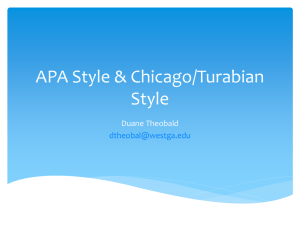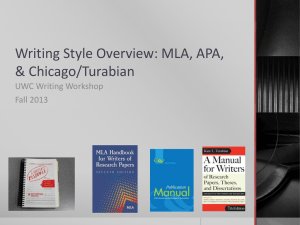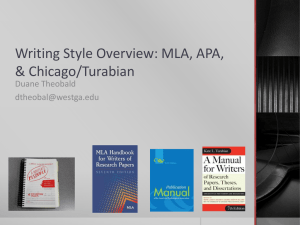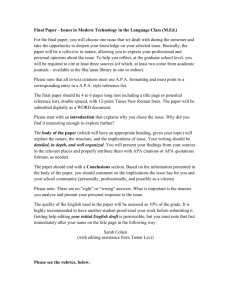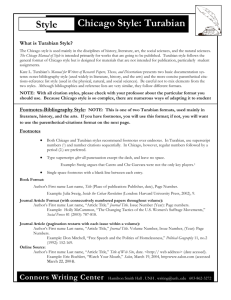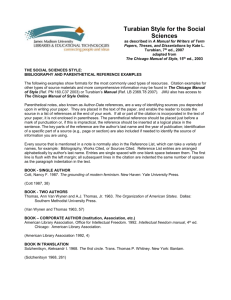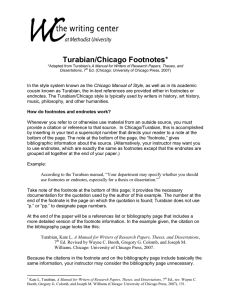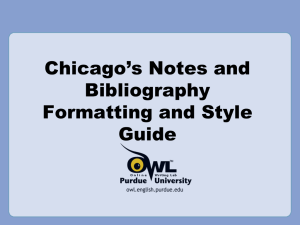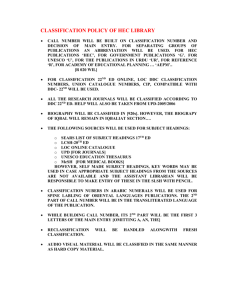APA Style - The University of West Georgia
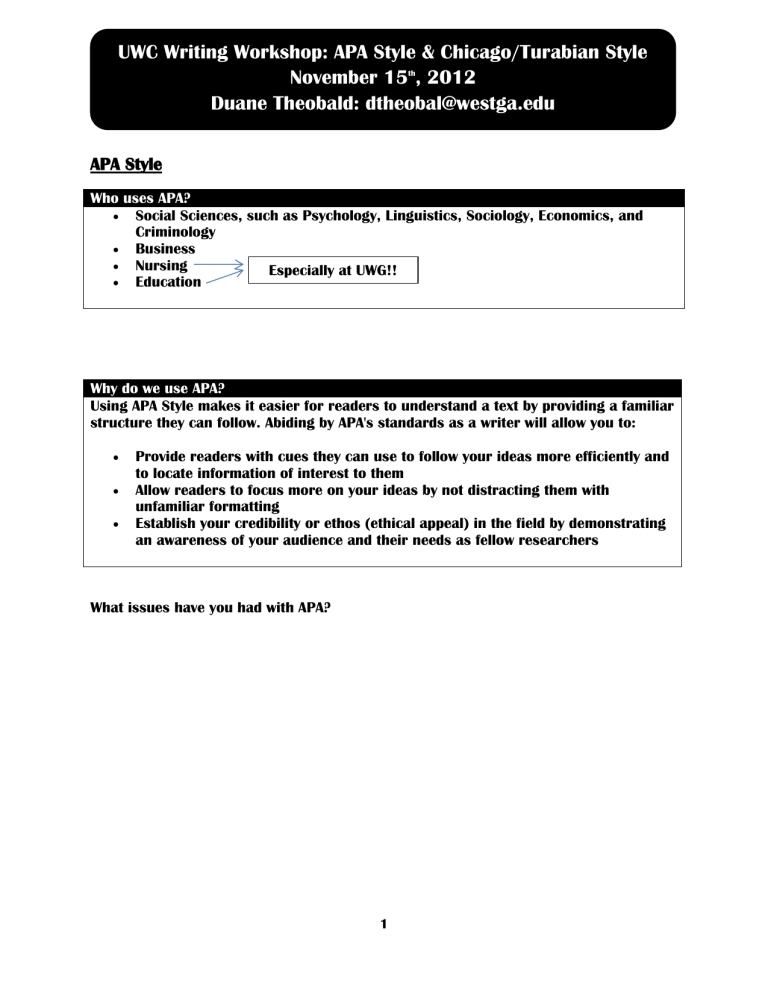
UWC Writing Workshop: APA Style & Chicago/Turabian Style
November 15
th
, 2012
Duane Theobald: dtheobal@westga.edu
APA Style
Who uses APA?
Social Sciences, such as Psychology, Linguistics, Sociology, Economics, and
Criminology
Business
Nursing
Education
Especially at UWG!!
Why do we use APA?
Using APA Style makes it easier for readers to understand a text by providing a familiar structure they can follow. Abiding by APA's standards as a writer will allow you to:
Provide readers with cues they can use to follow your ideas more efficiently and to locate information of interest to them
Allow readers to focus more on your ideas by not distracting them with unfamiliar formatting
Establish your credibility or ethos (ethical appeal) in the field by demonstrating an awareness of your audience and their needs as fellow researchers
What issues have you had with APA?
1
Overall Document
Format and
Appearance?
In-text
Aspects of APA
Citations?
References? Where to find aspects you can’t memorize?
Overall Document Format and Appearance?
When writing a paper in APA style, you need to make sure to:
Include 1 inch margins on all sides of the paper
Use a clear font that is highly readable (preferably Times New Roman, 12 pt.)
Double space throughout the document (exception: block quotes!)
Include a page header (also known as a “running head”); to create a page header: o Insert page numbers flush right, then type “TITLE OF YOUR PAPER” in the header flush left using all capital letters. The running head is a shortened version of your paper’s title and cannot exceed 50 characters, including spacing and punctuation
Must include four major sections: o Title Page: should contain the title of the paper, the author’s name, and the institutional affiliation o Abstract: a concise summary of the key points of your research (do not indent); should contain at least your research topic, research questions, participants, methods, results, data analysis, and conclusions; should be between 150-250 words o Main Body: the main focus of your paper (includes analysis of topic, quotes from sources, etc.) o References: shows to the reader what sources you used in your paper, where they came from, and if they are truly credible
In-Text Citations?
For all in-text citations, except those following block quotations, the reference is placed immediately before the final punctuation mark of the sentence that refers to that source. In all citations, elements (such as author, publication year, and page number) are separated from each other by commas.
Example #1 (more common citation):
“If the existence of a signing ape was unsettling for linguists, it was also startling news for animal behaviorists” (Davis, 1978, p. 26).
Example #2 (for a block quotation):
With the addition of so many new databases to the campus online system, many students were having difficulty locating the database they needed. At the same time, the role of Session Manager had evolved. The increased importance of the Session Manager
2
as a selection tool made it a part of the navigation process itself. (Eliasen, 1997, pp.
510)
*For more information about in-text citations for APA, I encourage you to consult the
Publications Manual of the American Psychological Association (pgs. 169-192).*
References?
Your reference page serves to show your reader exactly what sources you utilized in your paper, where they came from, and ultimately how credible they are in terms of content and overall scope. Note that different sources may be cited differently and have specific requirements for the citation to be complete and accurate.
Book:
Kurlansky, M. (2002). Salt: A world history. New York, NY: Walker and Co.
Chapter from an Edited Book:
Denmark, F.L. (1999). Enhancing the development of adolescent girls. In N.G. Johnson
& M. C. Roberts (Eds.), Beyond appearance: A new look at adolescent girls (pp. 377-
404). Washington, DC: American Psychological Association Press.
Article from a Scholarly Journal:
Fechner, P.Y. (2002). Gender differences in puberty. Journal of Adolescent Health, 4,
44-48.
Article from a Magazine:
Posner, M.I. (1993, October 29). Seeing the mind. Science, 262, 673-674.
Images from a Book:
Delaroche, Paul (1829) Portrait of a Woman, [Pastel Drawing]. From European
Drawings from the Collection of the Ackland Art Museum (pg. 93) by Carol C. Gillham and Carolyn H Wood, 2001, Chapel Hill: The Museum, University of North Carolina.
*For more information about reference pages and the citations therein, I encourage you to consult the Publications Manual of the American Psychological Association (pgs.
193-224).
Where to find aspects you can’t memorize?
Publications Manual of the American Psychological Association: this would be my first point of reference for this style. This book is fairly easy to navigate and provides a wealth of information about the style and how to use it efficiently.
OWL at Purdue: this website is wonderful in providing information concerning various writing styles: http://owl.english.purdue.edu/owl/resource/560/01/ .
3
Chicago/Turabian Style
Who uses Chicago? What about “Turabian”?
Scholars and students of history (UWG!), art, philosophy, business, and communications use Chicago or Turabian style.
“Turabian” refers to the author of a manual on Chicago style. Turabian is a simplified version of Chicago; for your purposes at UWG, you will be fine using guides to either. If a paper’s directions specify “use Turabian,” you can use a guide to Chicago and be fine.
What’s different?
The most noticeable feature of Chicago style is numbered in-text citations. This means footnotes or endnotes correspond to superscript numbers and give citation information at the bottom of the page or end of text. There are no parenthetical citations--like this, 1 not like this (Theobald, 2012).
What issues have you had with Chicago or Turabian?
1 Duane Theobald, Chicago Style is Awesome (Carrollton: University of West Georgia Press, 2012), 122.
4
Overall Document
Format and
Appearance?
Aspects of Chicago/Turabian
Footnotes? References? Where to find aspects you can’t memorize?
Overall Document Format and Appearance?
General guidelines for formatting a paper in Chicago/Turabian include:
Margins should be set at no less than 1 inch and no greater than 1.5 inches
Typeface should be something readable, such as Times New Roman or Palatino
Font size should be no less than 10 pt. (preferably, 12 pt.)
Text should be consistently double-spaced, with the exception of block quotes
Notes and bibliographies should be single-spaced internally; however, leave an extra line space between note and bibliographic entries
Page numbers begin in the header of the first page of text with Arabic number 1
Subheadings should be used for longer papers
Put an extra line space before and after subheadings, and avoid ending them with periods
Must include: o Title Page, with the title centered a third of the way down the page and your name and class information to follow several lines later o Main Body: where the central part of your argument for the paper is found here o Footnotes: serve as another form of an in-text citation; rather than cite a source in the course of your writing, you would create a footnote to reference the work you used o References: shows to the reader what sources you used in your paper, where they came from, and if they are truly credible
Please note that for Chicago/Turabian style, there are other subtle nuances (i.e.
Headings) that may need to be considered-ask your professor for further clarification and to see if it is needed!
Footnotes?
For footnotes, you will need to consider the following:
To insert a footnote, simply click on the “References” tab and click on “Insert
Footnote”
Note that numbers should begin with “1” and follow consecutively throughout a given paper
In the text, note that numbers are superscripted
5
The first line of a footnote is indented ½ inch from the left margin
Subsequent lines within a footnote should be formatted flush left
Leave an extra space between footnotes
References?
For your references page, you will need to remember the following:
Leave two blank lines between “Bibliography” or “References” and your first entry
Leave one blank line between remaining entries
List entries in letter-by-letter alphabetical order according to the first word in each entry
Use “and,” not an ampersand “&,” for multi-author entries o For two to three authors, write out all names o For four to ten authors, write out all names in the bibliography but only the first author’s name plus “et al” in notes and parenthetical citations o Write out publishers’ names in full
Examples:
Book:
Breen, T.H. 2004. The marketplace of revolution: How consumer politics shaped
American independence. New York: Oxford University Press.
Book with Multiple Authors:
Bird, Kai, and Martin J. Sherwin. 2005. American Prometheus: The triumph and tragedy of J. Robert Oppenheimer. New York: Alfred A. Knopf.
Journal Article with Date of Publication:
Burns, Sarah. 2005. Ordering the artist’s body: Thomas Eakins’ acts of self-portrayal.
American Art 19, no. 1 (Spring): 82-107.
Website:
Evanston Public Library Board of Trustees. Evanston Public Library strategin plan,
2000-2010: A decade of outreach. Evanston Public Library. http://www.epl.org/library/strategic-plan-00.html
(accessed June 1-August 15, 2005).
Visual Sources:
Lynes, Barbara Buhler, Lesley Poling-Kempes, and Frederick W. Turner. 2004. Georgia
O’Keefe and New Mexico: A sense of place. Princeton: Princeton University Press.
6
For more information about actual citations for the “Reference/Bibliography” page, visit http://citesource.trincoll.edu/chicago . This website provides links to many different examples for many different kinds of citations.
Where to find aspects you can’t memorize?
A Manual for Writers of Research Papers, Theses, and Dissertations (Chicago
Style for Students and Researchers: This text is quite helpful, but often a bit difficult to navigate. I suggest that you begin with Part II: Source Citation (begins on pg. 133 and continues through pg. 280).
OWL at Purdue: Like with APA, this website also contains information about
Chicago/Turabian style. For more information, visit http://owl.english.purdue.edu/owl/resource/717/01/ .
**Also, always feel free to visit the UWC anytime with any questions pertaining to style and how to navigate the different aspects therein.**
7
